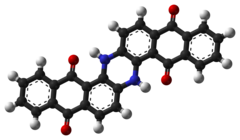Indanthrone blue

| |

| |
| Names | |
|---|---|
| Preferred IUPAC name
6,15-Dihydrodinaphtho[2,3-a:2′,3′-h]phenazine-5,9,14,18-tetrone | |
| Other names
C.I. vat blue 4, carbon paper blue, blue O, carbanthrene blue 2R, fenan blue RSN, graphtol blue RL, medium blue, monolite fast blue 3R, indanthrene, indanthrone, pigment blue 60, C.I. 69800
| |
| Identifiers | |
3D model (JSmol)
|
|
| 367131 | |
| ChemSpider | |
| ECHA InfoCard | 100.001.251 |
| E number | E130 (colours) |
PubChem CID
|
|
| UNII | |
CompTox Dashboard (EPA)
|
|
| |
| |
| Properties | |
| C28H14N2O4 | |
| Molar mass | 442.430 g·mol−1 |
| Appearance | dark blue solid |
| Density | 1.6 g/ml |
| Melting point | 470-500 °C (decomposes) |
| Insoluble | |
Except where otherwise noted, data are given for materials in their standard state (at 25 °C [77 °F], 100 kPa).
| |
Indanthrone blue, also called indanthrene, is an organic compound with the formula (C14H6O2NH)2. It is a dark blue solid that is a common dye as well as a precursor to other dyes.[1]
Preparation
The compound made from 2-aminoanthraquinone treated with potassium hydroxide.
Applications
It is a pigment that can be used in the following media: acrylic, alkyd, casein, encaustic, fresco, gouache, linseed oil, tempera, pastel, and watercolor painting. It is used to dye unmordanted cotton and as a pigment in quality paints and enamels. As a food dye, it has E number E130, but it is not approved for use in either the United States or the European Union.[2][3] It has excellent light fastness, but may bleed in some organic solvents.
Indanthrone blue was the first example of the brand "Indanthren" (an acronym for Indigo from anthracene) introduced by BASF in 1901.[4][5][6] One coincidental result is that even now, in Japan vat dyes are commonly described as thren(e) dyes (スレン染料), derived from the Japanese transliteration of the brand.[7][8]
References
- ^ Bien, Hans-Samuel; Stawitz, Josef; Wunderlich, Klaus (2000). "Anthraquinone Dyes and Intermediates". Ullmann's Encyclopedia of Industrial Chemistry. doi:10.1002/14356007.a02_355. ISBN 3527306730.
- ^ Summary of Color Additives for Use in the United States in Foods, Drugs, Cosmetics, and Medical Devices, Food and Drug Administration
- ^ Current EU approved additives and their E Numbers, Food Standards Agency
- ^ Entry on Indanthron-Pigmente. at: Römpp Online. Georg Thieme Verlag, retrieved 16. Januar 2013.
- ^ "Marken - Registerauskunft - Indanthren". DPMAregister (in German). Retrieved 29 August 2020.
Anmeldetag: 05.08.1901 / Inhaber: BASF AG
- ^ Zollinger, Heinrich (2003). Color Chemistry: Syntheses, Properties, and Applications of Organic Dyes and Pigments. John Wiley & Sons. p. 255. ISBN 978-3-906390-23-9. Retrieved 29 August 2020.
The German word Indanthren is an acronym for Indigo aus Anthrazen
- ^ "Colourful World III". www.eonet.ne.jp. Retrieved 29 August 2020.
バット染料の主たる製造元は、ドイツの化学会社でありその時の商標が、 "インダンスレン" であったことからスレン染料と呼ぶ場合も多くあります
- ^ "アルテモンド 豆知識 / スレン染料". www.artemondo.co.jp.
スレン染料(threne dye)とは、バット染料(vat dye)の俗称
